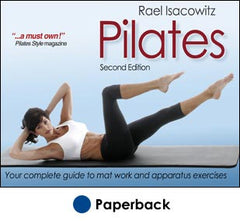Side Over and Basic Swan Exercises
This is an excerpt from Pilates-2nd Edition by Rael Isacowitz.
Side Over
Wunda chair
Lateral flexion
Fundamental
Muscle Focus
- Oblique abdominals
Objectives
- To develop control of the lateral flexors (particularly the oblique abdominals)
- To stretch the lateral flexors
This is an excellent exercise for teaching precise lateral flexion and correct alignment, thereby laying a foundation to later perform the same movement in more challenging positions on other pieces of apparatus. By adding small increments of spring tension, the exercise can be made less challenging, if necessary. By the same token, decreasing the spring tension will make the exercise more challenging. From a teacher's perspective, the student's body is in an ideal position for cueing and offering input and corrections.
Imagery
Imagine the movement as being two-dimensional, occurring between two panes of glass preventing you from leaning forward or backward.
- Lift no higher than the diagonal line created by the straight leg and trunk.
- Keep the legs and pelvis stable, with the foot of the straight leg anchored on the floor.
- Move from the waist area.
http://www.humankinetics.com/AcuCustom/Sitename/DAM/118/E5764_262940_ebook_Main.jpg
Exhale. Sit sideways on the chair, hooking the lower leg on the side of the chair and keeping the other leg straight and in line with the body. Establish a long diagonal bodyline, with the foot touching the floor. Place the lower hand on the pedal and the other hand behind the head.
http://www.humankinetics.com/AcuCustom/Sitename/DAM/118/E5764_262941_ebook_Main.jpg
Inhale. Laterally flex the trunk, lowering the pedal. Exhale. Lift the trunk, raising the pedal and returning to the start position.
http://www.humankinetics.com/AcuCustom/Sitename/DAM/118/E5764_IMG_0904_ebook_Main.jpg
Variation
To increase both the load and the stretch of the lateral muscles of the trunk and underarm, reach the top arm overhead with the shoulder internally rotated, and the palm facing up toward the ceiling.
Basic Swan
Wunda chair
Back extension
Fundamental
Muscle Focus
- Back extensors
Objectives
- To strengthen the back extensors
- To develop scapular stabilization
- To emphasize abdominal control
As with the Wunda Chair: Side Over, this exercise can be made easier by adding small increments of spring tension or more challenging by reducing the spring tension. This adjustability is invaluable when dealing with back problems because you can regulate how much muscle activation should be present as well as the range of motion of the trunk. The springs can move the body through a predetermined range of motion via almost-passive movement as neuromuscular patterns are reeducated, and then the muscles can be progressively challenged (by decreasing the tension) as improvement takes place.
This exercise is valuable for teaching the crucial role of the abdominal muscles during spinal extension and the skill of load distribution through the spine when executing back extension exercises. Often, as soon as the abdominal muscles are activated there is a tendency to draw the trunk into flexion. As a result, when the trunk is then lifted, the majority of the extension occurs in the lumbar spine, placing excessive load on this region. This is completely contrary to the effect we are striving for. Correct abdominal activation should provide support for the spine and, together with the back extensors, assist in creating a long, evenly distributed arc through the trunk.
Imagery
Visualize a reverse articulation of the spine, starting with the head and moving down the spine, drawing the trunk into extension. This tends to distribute the work throughout the back and establishes a gentle arc shape, rather than excessive hyperextension in the lumbar region.
- Maintain abdominal muscle engagement throughout.
- Keep the legs parallel to the floor.
- Press the hands back into the pedal, extending the shoulders, as the body lifts.
http://www.humankinetics.com/AcuCustom/Sitename/DAM/118/E5764_262943_ebook_Main.jpg
Exhale. Lie prone on the chair with the legs straight and together, parallel to the floor. Place the hands on the pedal, aligning them directly under the shoulders, and straighten the arms. The pedal may be slightly off the base of the chair.
http://www.humankinetics.com/AcuCustom/Sitename/DAM/118/E5764_262944_ebook_Main.jpg
Inhale. Extend the back, lifting the pedal. Exhale. Lower to the start position.
http://www.humankinetics.com/AcuCustom/Sitename/DAM/118/E5764_IMG_0907_ebook_Main.jpg
Variation
To reduce the challenge, place the feet on a box or ball so that the alignment is still horizontal and parallel to the floor, but the feet are supported. If this still proves too challenging, the feet can be placed on the floor with the knees bent and thighs pressing against the back of the chair.
Learn more about Pilates, Second Edition.
More Excerpts From Pilates 2nd Edition

Get the latest insights with regular newsletters, plus periodic product information and special insider offers.
JOIN NOW


